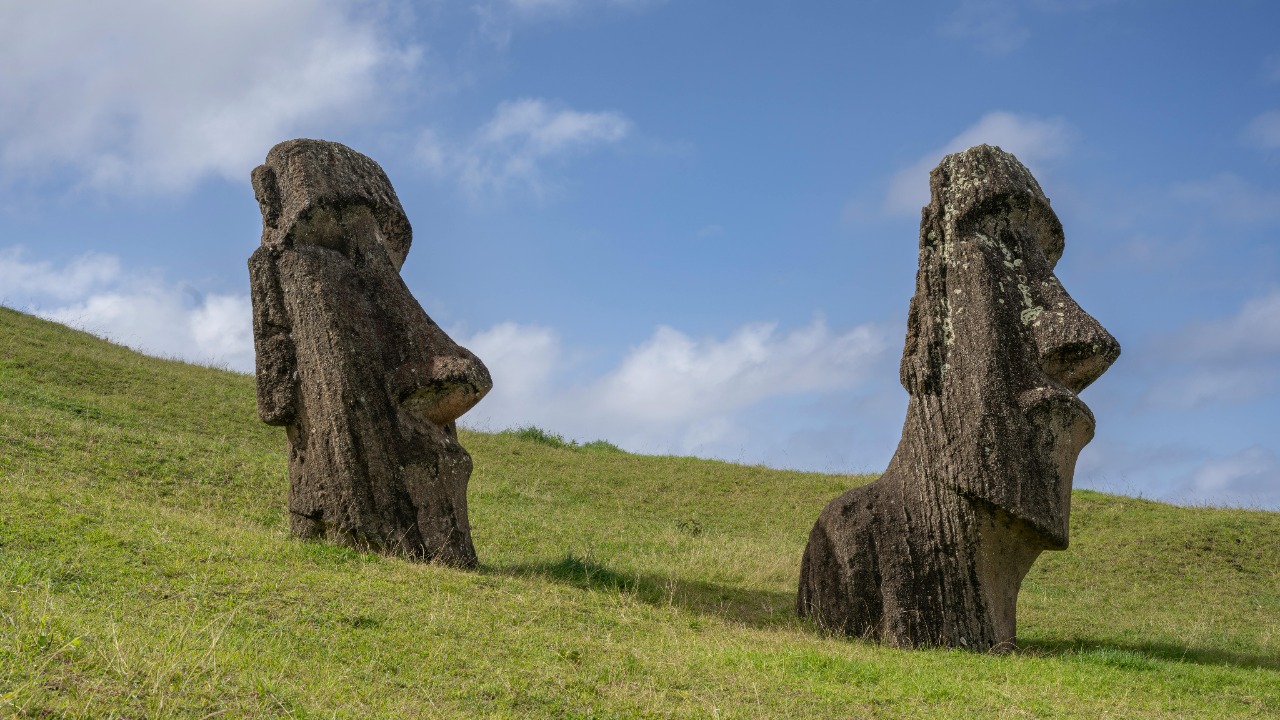
After centuries of speculation, scientists have finally cracked the mystery of how the massive Moai statues were transported across Easter Island. A recent study has revealed that these ancient figures, weighing up to 80 tons, could “walk” upright using ropes and minimal manpower, thereby resolving an 800-year-old enigma. This breakthrough challenges long-held assumptions about the engineering feats of the Rapa Nui people and suggests that teams of just 18 people could maneuver each statue over rugged terrain without the need for sledges or rollers.
The Mystery of Easter Island’s Moai Statues
The Moai statues of Easter Island have intrigued historians and archaeologists for centuries. Carved from volcanic tuff between approximately 1250 and 1500 CE, over 900 of these monolithic figures stand tall on the remote Pacific island, averaging 13 feet in height and 14 tons in weight. The mystery deepens when considering their placement; many were quarried at the Rano Raraku site but erected miles away along the island’s coast, sparking centuries of speculation on the methods of their transport.
When European sailors like Jacob Roggeveen first encountered the statues in 1722, they were puzzled by their remote locations and the lack of visible tools or roads. This enigma fueled numerous theories and hypotheses over the years, each attempting to explain how the Rapa Nui people could have moved these colossal figures.
Previous Theories on Statue Transportation
One of the earliest theories, proposed by archaeologists like Thor Heyerdahl in the 1950s, suggested that the statues were transported using wooden sledges and log rollers. However, this hypothesis faced criticism as it required vast timber resources, which were scarce on the deforested island. Another theory, rooted in Rapa Nui oral traditions, described the statues being tilted and rocked forward, as if “walking”. This idea was largely dismissed by Western scholars as myth until its recent validation.
Other ideas included sea voyages on rafts or partial disassembly of the statues. These theories were tested in experiments by Charles Love in the 1980s but were ultimately deemed inefficient given the scale of the statues.
The Breakthrough Study Using Physics
A groundbreaking 2025 research study led by engineers from the University of Hawaii has provided a new perspective on this enduring mystery. Published in the Journal of Archaeological Science, the study applied biomechanical modeling to simulate Moai movement. The core finding of the study was that the statues could be balanced on their narrow bases and “walked” by swaying side-to-side with ropes pulled by small teams. This method reduced friction and required no deforestation.
The study also provided experimental proof of this method. A 10-foot replica statue was successfully moved 100 meters by 18 volunteers in under an hour, mimicking the techniques that the ancient Rapa Nui people might have used.
How the “Walking” Method Worked
The “walking” method involved a rocking mechanism where ropes attached to the statue’s head created a pendulum effect. This allowed the statue to step forward incrementally across uneven ground without tipping. The minimal crew size required for this method was just 18 people—10 on each side pulling in unison plus stabilizers. This was sufficient for moving statues up to 80 tons, as calculated through computer simulations.
The method also addressed the challenges posed by the terrain of Easter Island. The volcanic slopes and soft soils of the island could be navigated using this method, with the statue’s curved base acting as a natural pivot.
Implications for Rapa Nui Society
The walking technique underscores the ingenuity of the Rapa Nui people. It enabled the erection of the statues without large-scale logging, suggesting that the island’s ecology was preserved for longer than previously thought. The findings also connect to broader Polynesian navigation and engineering practices, suggesting that the transport of the Moai was a communal ritual that strengthened social bonds across the island’s clans.
The study also sparks ongoing debates, including how it resolves ecological collapse theories by reducing the need for timber. This could potentially rewrite timelines of the civilization’s decline in the 17th century.
Expert Reactions and Future Research
Archaeologists like Jo Anne Van Tilburg have praised the study for bridging physics and anthropology, calling it a “game-changer” for understanding non-Western technologies. The study has also received endorsements from Rapa Nui descendants, who see the validation of their ancestors’ oral histories as cultural vindication after 500 years of colonial dismissal.
Looking ahead, there are plans for further research, including full-scale trials on the island and 3D modeling of all Moai paths. This will help map ancient labor routes and ceremonial sites, providing even more insights into the fascinating history of the Rapa Nui people and their remarkable Moai statues.